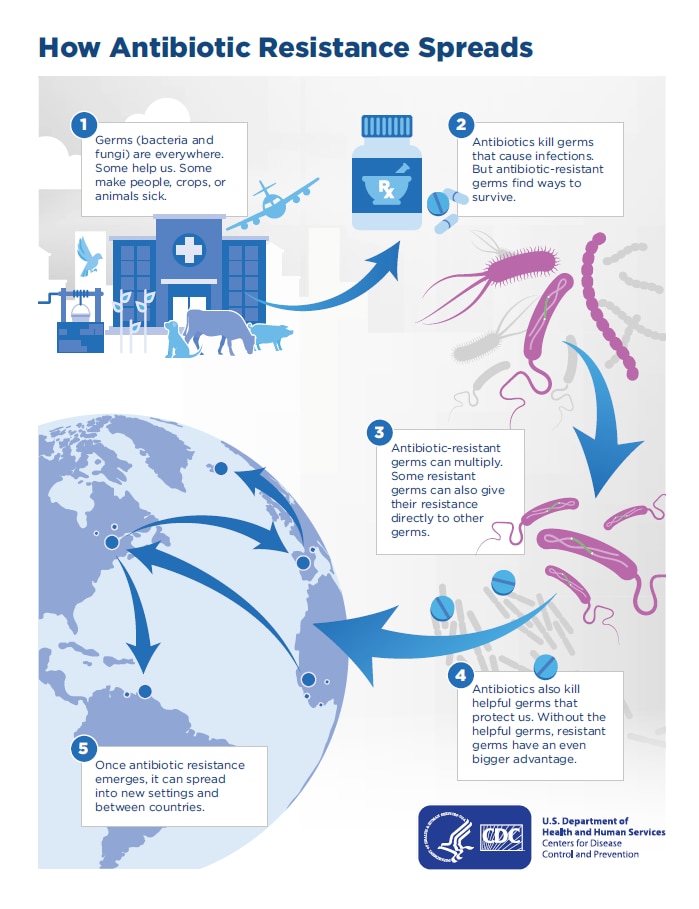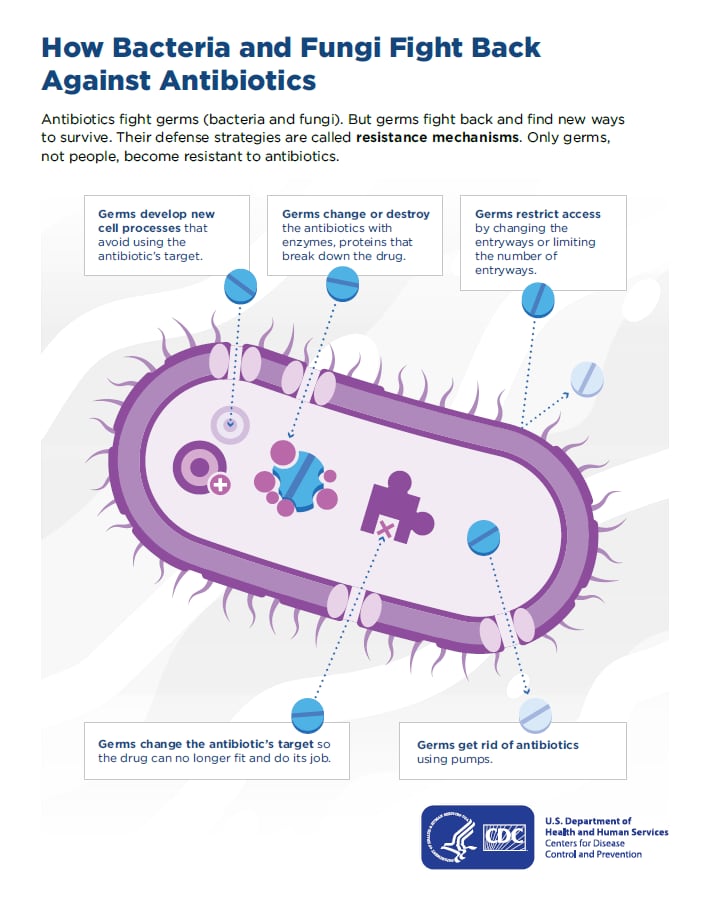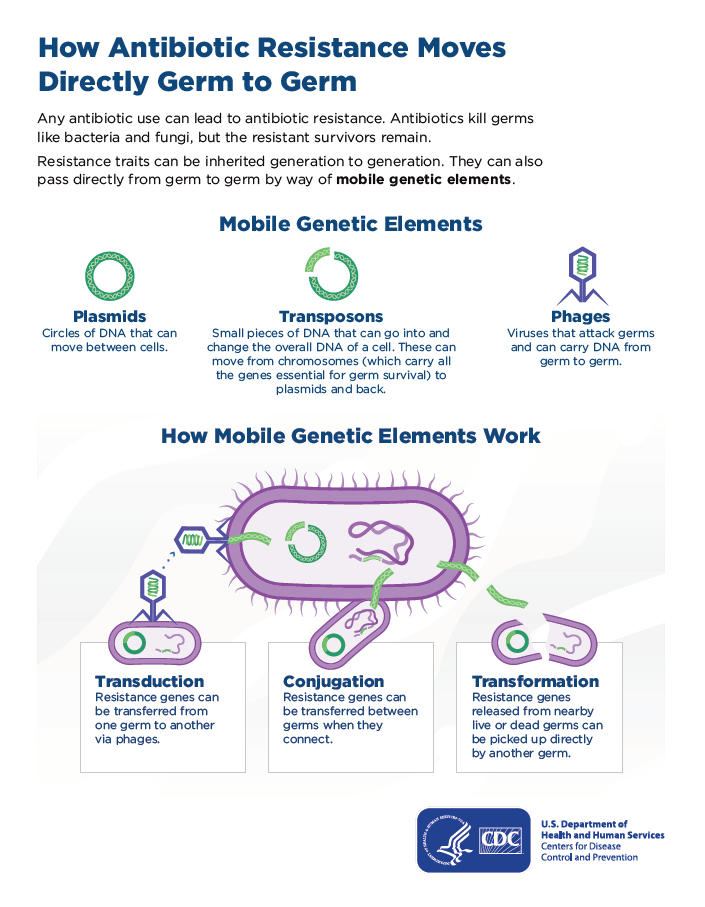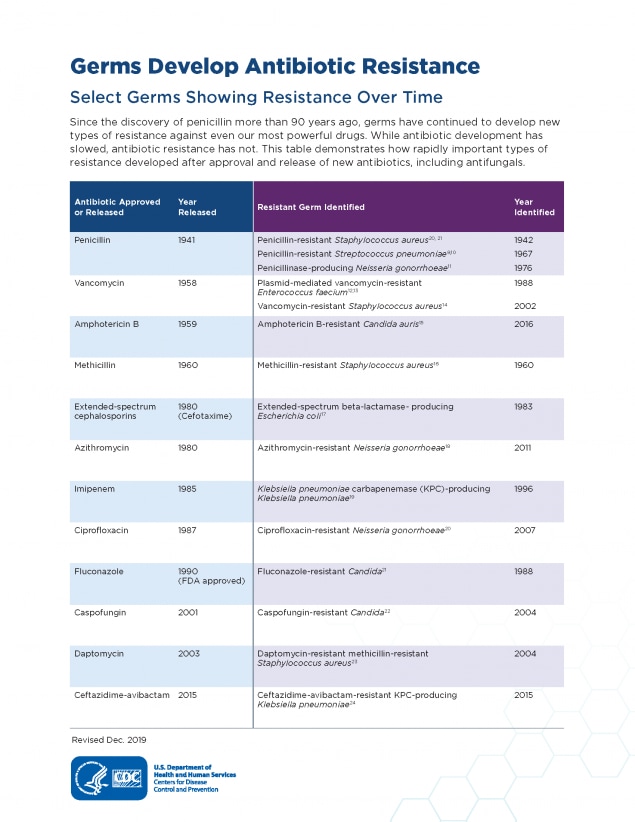How Antimicrobial Resistance Happens
Antimicrobial resistance happens when germs like bacteria and fungi develop the ability to defeat the drugs designed to kill them. Resistant infections can be difficult, and sometimes impossible, to treat. Antimicrobial resistance is a naturally occurring process. However, increases in antimicrobial resistance are driven by a combination of germs exposed to antibiotics and antifungals, and the spread of those germs and their resistance mechanisms.
Definition of Germs & Antimicrobials
Antimicrobial resistance does not mean our body is resistant to antibiotics or antifungals. It means the bacteria or fungi causing the infection are resistant to the antibiotic or antifungal treatment.
- Germs are microbes—very small living organisms including bacteria, fungi, parasites, and viruses.
- Most germs are harmless and even helpful to people, but some can cause infections. Harmful germs are called pathogens.
- Antimicrobials is a term used to describe drugs that treat many types of infections by killing or slowing the growth of pathogens causing the infection. The content on this webpage does not include resistance to antivirals or antiparasitics.
- Bacteria cause infections such as strep throat, foodborne illnesses, and other serious infections. Antibiotics treat bacterial infections.
- Fungi cause infections like athlete’s foot, yeast infections, and other serious infections. Antifungals treat fungal infections.
- People sometimes use “antibiotic” and “antimicrobial” interchangeably.
Patients should always be promptly treated with antibiotics/antifungals when the drugs are needed for infections and to treat sepsis.
How Antibiotic and Antifungal Use Affects Resistance
Antibiotics and antifungals save lives, but their use can contribute to the development of resistant germs. Antimicrobial resistance is accelerated when the presence of antibiotics and antifungals pressure bacteria and fungi to adapt.
Antibiotics and antifungals kill some germs that cause infections, but they also kill helpful germs that protect our body from infection. The antimicrobial-resistant germs survive and multiply. These surviving germs have resistance traits in their DNA that can spread to other germs.
Spread of Germs & Resistance Mechanisms
To survive, germs can develop defense strategies against antibiotics and antifungals called resistance mechanisms. DNA tells the germ how to make specific proteins, which determine the germ’s resistance mechanisms. Bacteria and fungi can carry genes for many types of resistance.
When already hard-to-treat germs have the right combination of resistance mechanisms, it can make all antibiotics or antifungals ineffective, resulting in untreatable infections. Alarmingly, antimicrobial-resistant germs can share their resistance mechanisms with other germs that have not been exposed to antibiotics or antifungals.
This table gives a few examples of defense strategies used to resist the effects of antibiotics or antifungals.
| Resistance Mechanisms (Defense Strategies) |
Description |
|---|---|
| Restrict access of the antibiotic | Germs restrict access by changing the entryways or limiting the number of entryways.
Example: Gram-negative bacteria have an outer layer (membrane) that protects them from their environment. These bacteria can use this membrane to selectively keep antibiotic drugs from entering. |
| Get rid of the antibiotic or antifungal | Germs get rid of antibiotics using pumps in their cell walls to remove antibiotic drugs that enter the cell.
Example: Some Pseudomonas aeruginosa bacteria can produce pumps to get rid of several different important antibiotic drugs, including fluoroquinolones, beta-lactams, chloramphenicol, and trimethoprim. Example: Some Candida species produce pumps that get rid of azoles such as fluconazole. |
| Change or destroy the antibiotic | Germs change or destroy the antibiotics with enzymes, proteins that break down the drug.
Example: Klebsiella pneumoniae bacteria produce enzymes called carbapenemases, which break down carbapenem drugs and most other beta-lactam drugs. |
| Change the targets for the antibiotic or antifungal | Many antibiotic drugs are designed to single out and destroy specific parts (or targets) of a bacterium. Germs change the antibiotic’s target so the drug can no longer fit and do its job.
Example: Escherichia coli bacteria with the mcr-1 gene can add a compound to the outside of the cell wall so that the drug colistin cannot latch onto it. Example: Aspergillus fumigatus changes the cyp1A gene so that triazoles cannot bind to the protein. |
| Bypass the effects of the antibiotic | Germs develop new cell processes that avoid using the antibiotic’s target.
Example: Some Staphylococcus aureus bacteria can bypass the drug effects of trimethoprim. |

How Resistance Spreads

Bacteria and Fungi Fight Back

How Resistance Moves Directly Germ to Germ

Select Germs Showing Resistance Over Time